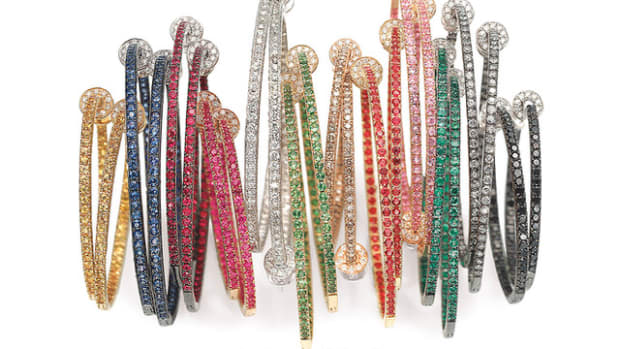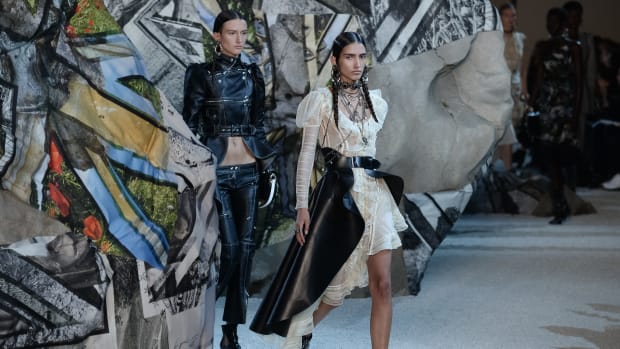How much would you pay for a white T-shirt? $5? $20? $50?
Whether you care about brand names, sustainability credentials, material options or not, cost is one of the biggest
factors that influences our buying decisions. Clothing has never been more affordable or accessible, with everything from ultra-cheap fast-fashion brands like Shein, FashionNova and Boohoo to high street giants like Zara and H&M available to shop 24/7 with just a few taps on our devices. For the cost of a coffee, you can buy a whole new outfit. Meanwhile, we're bombarded with messaging telling us to buy, buy, buy, with a host of incentives to spur us along: sales every other week, free shipping, free returns — you name it. That handbag you browsed yesterday? It now follows you around the internet via pop ups and targeted ads. Social media platforms have slowly evolved from community and content platforms into shopping destinations.
But do you know where the money ultimately ends up?
The Clean Clothes Campaign, an international network of NGOs fighting for better working conditions in fashion's supply chains, estimates that the garment worker who sewed your shirt received just 3% of the price you paid for it. The people leading the brands that made it, though, are worth billions: The Forbes 2021 Billionaires List is full of fashion industry moguls who have made their fortune off the backs of garment workers that struggle to survive. (Zara's founder, Amancio Ortega, for one, is worth $58 billion.)
While the price of consumer goods has risen with inflation over the last 30 years, U.S apparel prices have been stagnant. Global supply chain issues and material shortages caused by the pandemic mean that the cost of our clothes is set to rise by at least 3%, up to more than 10% this year, per a 2022 "State of Fashion" report from Business of Fashion and McKinsey & Company. Meanwhile, we're buying farmore and more.
"People simply don't understand that many of the low prices we see, especially on the high street, come from the exploitation of others," says Aja Barber, a UK-based American writer, consultant and author of "Consumed: The Need for Collective Change." "I tell people to look at the hourly wages we expect to pay ourselves, then learn about the labor which goes into making clothing or even better, attempt to sew a garment yourself. Once folks do that, they do start to grasp that much of the pricing we see is exploitative."
In 2019, Swiss NGO Public Eye broke down the cost of a Zara hoodie, from farm to final product, and found that the Spanish brand made more profit from one €26 ($29) black hoodie with R.E.S.P.E.C.T emblazoned across the chest (the irony!) than all the workers in the supply chain put together. Much attention andactivism has focused on the ways European and American fashion brands exploit garment manufacturers in places like Bangladesh, China, India and Vietnam, but worker wage theft also occurs closer to home: In 2020, investigations into the factories making clothing for Boohoo in Leicester, U.K., uncovered that the fast-fashion brand was paying garment workers £3.50an hour — much lower than the national minimum wage; in early 2022, garment workers in Haiti staged protests demanding an increase in wages from 500 gourdes ($5) to 1,500 gourdes ($15).
More transparency in pricing is crucial to educating consumers about where exactly their money is going. The price tag on your clothes has to factor in the materials, trims and hardware; labor, packaging, transportation, taxes; and of course a retail markup, which is usually 2.2 xthe production cost. When all these are added up, it becomes clear that someone is losing out in this equation.
"It's a wholly unsustainable model," says Ilana Winterstein, urgent appeals campaigner for the Clean Clothes Campaign. "If we want to be ethical — and if any brand wants to be ethical — it can't be part of this, producing more and more with quicker turnaround times."
New research from The Industry We Want reveals that the gap between what garment workers are earning and what they should be earning is 45%. It's not just a few bad apples, though: This problem is systematic.
"Because of this lack of transparency, there may be a misconception that you pay more and it's good, you pay less and it's bad. But the whole industry isn't set up with human rights in mind," says Winterstein. "It's not to say there aren't some brands that are better and some that are worse, but from our perspective, there isn't a single high street brand that's paying all their workers a living wage."
Most brands would agree that workers in their supply chains should be earning a living wage, but they draw the line at being held responsible. If, on the rare occasion they do make commitments and set targets, they go suspiciously quiet when they fail to meet them. Take H&M, for example — the Swedish fashion group made a pledge in 2013 to pay a living wage to the 850,000 garments in their supply chain by 2018, butaccording tothe Clean Clothes Campaign, that didn't and hasn't happened. Since then, H&M has been linked to wage theft in theSindh province in Pakistan, as well as to suppliersin the Xinjiang region of China. (Fashionista has reached out to H&M for comment.)
"What's really important to understand about this industry is that the brands are the ones with the power," says Winterstein. "If H&M really wanted to do this, nothing can be impossible for them, because the industry is built around what they need and want. It's just that it works better the way it is for these brands. That's the problem."
It's common practice for brands to "chase the needle" around the world, so to speak, in search for the cheapest factories. They'll pit suppliers against each other, forcing them to produce items for the lowest possible price; then, to stay in a brand's good books, factories will agree to impossible production targets and cut corners to save money, putting their workers' lives in danger in the process. Many brands don't own the factoriesthat make their product, a fact they'll use to excuse not paying living wages — it's out of their hands, they'll argue.
"All the risk is passed down until it rests on the garment workers, and they're the ones who have short term contracts, no money and unsafe working conditions," says Winterstein. "They shoulder the entire risk of this global industry that allows total fluidity for brands. There's no accountability. They can cut and run when they want."
Recommended Articles
With all this in mind, it feels unlikely that brands would choose to absorb the costs of paying workers a fair wage. Would higher prices on the consumer side equate to a more equitable industry?
"If we're to have a system in which the workers get paid a living wage and the environmental impact is under control, will it be a more expensive endeavor than the cheapest of cheap fast fashion? Yeah, probably," says Maxine Bédat, founder of the New Standard Institute. "How much that will be is another question."
Clean Clothes Campaign has suggested that it would cost brands as little as 10 cents per T-shirt to ensure that the garment workers that made it had livable wages. "It wouldn't be enormously more expensive, which is why we've become so focused on legislation and what can be done to ensure that the system gets the money to garment workers," says Bédat.
After years of almost no government intervention on the industry's rampant profit-at-any-cost practices, the last 18 months has seen a handful of ambitious pieces of legislation that could force brands to shape up. In California, the Garment Worker Protection Act, signed into law last year, scrapped the piece rate (which paid workers as little as $.03 per task) and secured minimum wage agreement for more than 40,000 people. In New York, the Fashion Sustainability Act is a new bill that, if passed, would make brands with over $100 million in revenue map and disclose their supply chains, along with information about wages and steps taken to pay their workers properly.
Currently, how much information brands share with their audience about how their products are made is entirely up to them, but legislation like the Fashion Act could make this radical transparency mandatory. Everlane and Maison Cléo provide a price explanation alongside each item on their online stores, helping customers to understand exactly what they're paying for. There are also a number of tech solutions emerging to help brands with traceability: In New York, EON creates digital IDs in the form of NFC (near field communication) tags or QR codes for brands like Pangaia and Gabriela Hearst, which reveal all sorts of information about a product, from material composition to details of the factories where it was made.
We can't talk about raising the cost of clothing without recognizing the impact that would have on people who simply can't afford to spend more on clothing. "All of this legislation shouldn't be happening in isolation from addressing income inequality and understanding why we're in this place where some people can't afford clothing, or why people feel forced to consume fast fashion," says Bédat. "That also has to take place in order to address the whole system."
In recent years, there's been more conversation about (and scrutiny on) privilege within the sustainable fashion movement, especially when people feel shamed or judged for buying fast fashion because they might not have the means to spend more on their clothes — after all, a common complaint about sustainable fashion is that it's too expensive. There is however, a difference between a person who consciously buys clothing from fast fashion retailers because it's what they can afford versus content creators who buy boxes of throwaway clothes regularly to film haul videos for Youtube that will end up in landfill faster than you can say, "Like and subscribe!"
"Many use that reasoning to excuse all exploitative purchases, and that's wrong,” says Barber. "A person spending $200 on fast fashion a month can definitely make different choices. But within my book 'Consumed,' I discuss that I personally believe the only way to change the game is to rally and fight for a rise in wages for all. Let's fight for a world where no one feels forced to buy the dress made in a sweatshop."
Of course, everyone has a different definition of expensive and affordable, and this can fluctuate depending on your financial circumstances. Bédat suggests that defining those parameters for yourself is one way to shop more consciously and avoid the allure of buying something just because it's cheap.
"I don't agree with the belief that fast fashion is terrible all the time and if you do it, you're evil,” she says. "That's wrong. It totally ignores people's economic situations. But if someone can navigate what feels substantive to them, ensuring they're being thoughtful about it, that's a really good way of going about it."
Another way to get used to the idea of paying more for fashion is to realize that the industry operates on deception: Brands take advantage of our insecurities and tell us we're getting a great deal when we're not. Buying cheap clothes that you have to throw away after two wears isn't exactly the definition of a bargain.
"Nobody wants to be duped. That's why it’s so important to get out these stories of how much of this is manipulation," says Bédat. "Of course, our brains are wired to want stuff, but that want is being manipulated for a few people to make a lot of money. We can't ignore the massive economy behind getting us here in the first place."
Like it or not, inflation means we'll be spending more at the till for clothing. But more education, accountability through legislation and transparent dialogue between brands and consumers are going to be the defining factors in getting shoppers to shift our thinking on what clothing should actually cost.
"I think it would take some unlearning before we get there. People are so used to low prices and will argue until they're blue in the face with living wage employers that something is unfairly priced," says Barber. "There needs to be more dialogue about why this is crappy behavior. We either want people to pay folks or we don't."
Never miss the latest fashion industry news. Sign up for the Fashionista daily newsletter.



